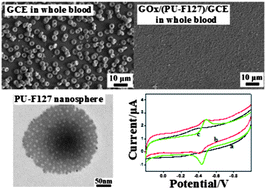Analysts are always enthusiastic about finding new materials with good biocompatibility to improve the behavior of biosensors. In this case, a novel electrochemical biosensor, which can be conveniently applied to veraciously evaluate the level of blood glucose with the help of antibiofouling technology, was prepared and investigated. More details of the preparation of polyurethane-Pluronic F127 (PU-F127) nanospheres and immobilizing glucose oxidase (GOx) on (PU-F127)–glass carbon electrode (GCE) were presented. The electrochemical behavior of the biosensor in whole blood was studied. The cyclic voltammetric results indicated that GOx immobilized on the PU-F127 nanospheres exhibited direct electron transfer reaction, which led to stable amperometric biosensing for glucose with a detection limit of 1.14 × 10−5 M (S/N = 3) in whole blood. The PU-F127 nanospheres modified GCE also offered good anti-interference ability to ascorbic acid (AA) and uric acid (UA), especially when a detection potential of −0.49 V was employed. The good stability and repeatability of this biosensor were also proved. The integration of the technologies, which include anticoagulants, sensors and nanoscience, will have significant input to high-performance biosensors relevant to diagnostics and therapies of interest for human health.

You have access to this article
 Please wait while we load your content...
Something went wrong. Try again?
Please wait while we load your content...
Something went wrong. Try again?


 Please wait while we load your content...
Please wait while we load your content...